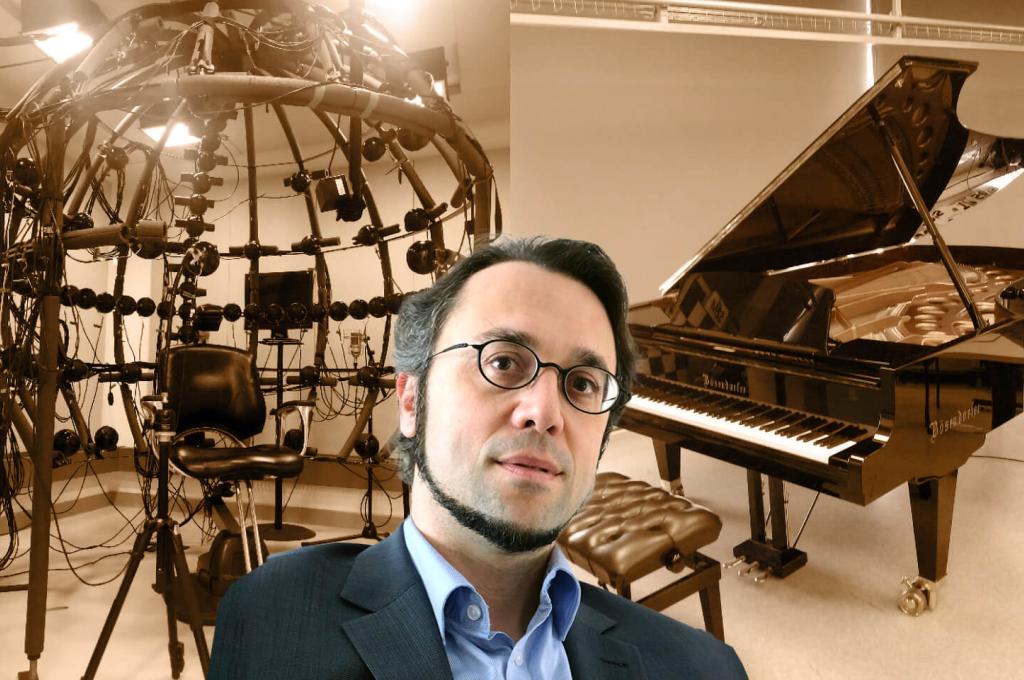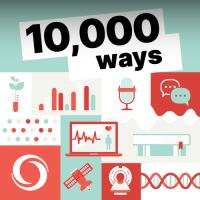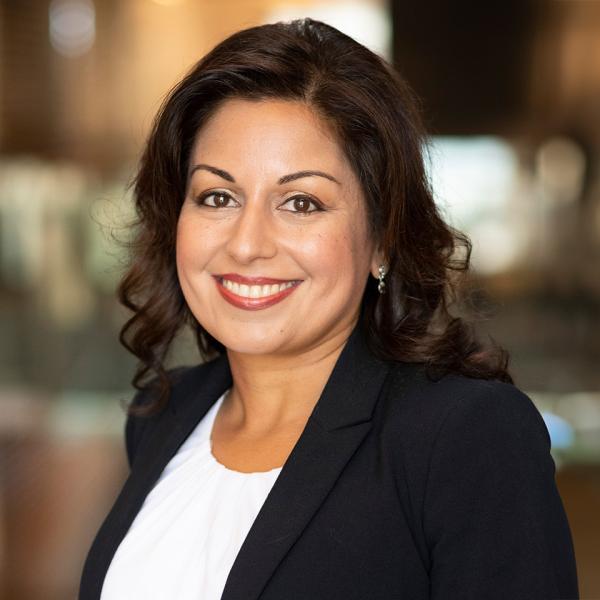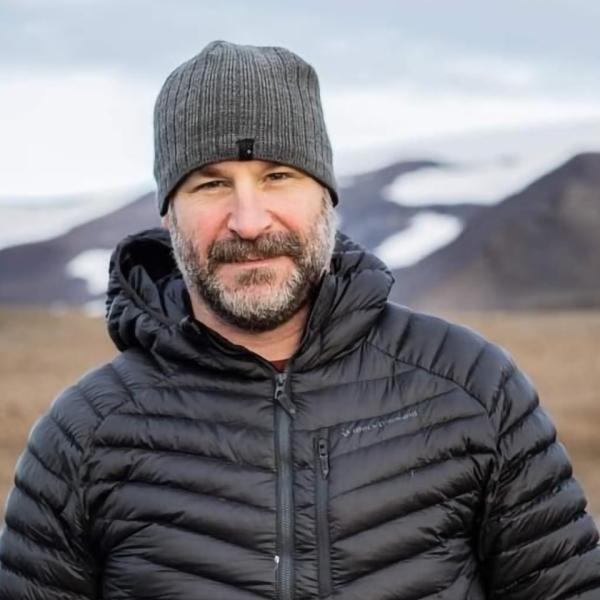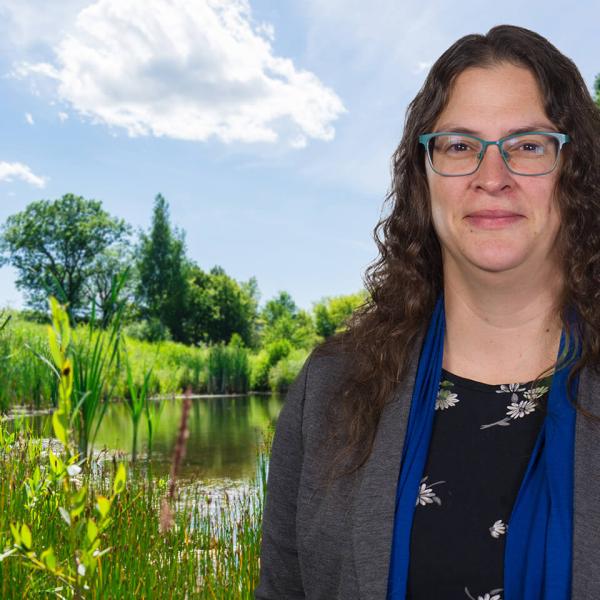Host:
This is a Canada Foundation for Innovation podcast.
(Music in)
Host:
Hello and welcome to 10,000 ways. This is a podcast about curious researchers, leading-edge science and the joys of discovery.
Simone Dalla Bella:
Hi, I’m Simone Dalla Bella, a professor at the Université de Montréal’s psychology department and the co-director of BRAMS, the International Laboratory for BRAin, Music and Sound Research.
Host:
Our podcast gets its name from Thomas Edison, who said, “I have not failed. I’ve successfully found 10,000 ways that will not work.”
(Music out)
…
(Music in)
When I was 12 years old, I spent a summer vacation at my aunt and uncle’s house. My uncle had this one t-shirt with a Nietzsche quote on it that I thought was so perfect. I wanted to sneak into their wardrobe and take off with it.
The shirt said, “Without music, life would be a mistake.”
This love of music is probably why, when I was offered the opportunity to interview Simone Dalla Bella, I didn’t think twice!
Even his name has such a lovely melody, a pleasing inflection, a delightful rhythm and a wonderful sing-song quality!
So, let’s launch into a few verses and variations on his life’s focus: music.
Simone Dalla Bella:
In a way, music has always been part of my life. I’m so lucky. I consider myself to be extremely lucky to be able to continue to approach music research from a very scientific standpoint. It’s like they say, once music is in your heart, it stays with you forever.
(Music out)
Host:
International Laboratory for Brain, Music, and Sound Research (also known as BRAMS) is a work and research space unlike any other.
(Music in)
BRAMS is based in Montréal and jointly affiliated with the Université de Montréal and McGill University.
The laboratory is dedicated to research in music and auditory cognition, with a focus on neuroscience.
BRAMS boasts one of the most comprehensive, state-of-the-art technological platforms in the world.
Simone Dalla Bella:
It’s such a privilege to work at the BRAMS laboratory and in an ecosystem as unique as Montréal’s. We have this tremendous opportunity to be working against a backdrop that’s brimming with ideas about music; it’s an effervescent environment that’s extremely conducive to research in the field.
(Music out)
Host:
What do you need to study music and neuroscience?
What does it look like inside BRAMS?
Well, we have soundproof rooms, a dome with 80 speakers and a motion capture lab for running tests are conducted on the body’s ability to move in sync with music.
The laboratory also has a functional near-infrared spectroscopy system, a transcranial magnetic stimulation system and electroencephalography systems to look at brain activity.
(Music in)
BRAMS researchers also have access to the only digital Bösendorfer piano in North America. This piano has the acoustic property of being better at transmitting sound than reflecting it. It’s also notable for making use of highly accurate sensors to record performances, store them digitally and reproduce them.
(Music out)
It’s a sophisticated tool that allows for a better understanding of musicality on a fundamental level.
(Music in)
So, what do you do with all these … instruments (in every sense of the word!)?
Simone Dalla Bella:
So, in my laboratory at BRAMS, we’re interested in the relationship between music and the brain in general, right? And how our brain detects, reacts to and moves to music.
We know that some people have no problem detecting a beat but have trouble matching the rhythm of a song or moving along to music, and the other way around.
We know that some people can move in sync with music but have issues when it comes to the perception part. So what does that mean? It means that we’re dealing with a whole degree of difference, and, right now, we’re interested in studying that particular degree of difference to better define it and determine how these differences relate to other cognitive skills, like memory and attention span, what we refer to as the executive functions that govern our ability to respond to stimuli, to perform everyday tasks, etc.
(Music out)
Host:
And what about you? Does music help you perform your daily tasks better? Or is it actually the opposite?
(Music in)
Simone Dalla Bella:
Several brain circuits are activated when someone starts to move their body along to a musical beat. Those circuits are generally the same ones that are activated during other types of motor activities, like walking or talking. So, there’s a common fundamental mechanism that drives all these different activities.
The theory behind our current research is to show that we actually can use music to train these brain networks. We already know that music is an extremely powerful stimulus for eliciting a motor response.
So, we try to harness that ability. It’s an ability that has wide-ranging effects, so it’s going to train the entire system underpinning the process. And when you train that system, you create what is called a “transfer effect” to other areas, such as to motor skills like talking and walking. So, in a way, we’re leveraging that.
And that can affect the speaking ability of someone with a stutter, patients with Parkinson’s disease or people with other types of speech disorders. And that specific ability is what usually generates interest in using music as a rehab tool.
(Music out)
Host:
Again, it turns out Nietzsche was right; music does have healing power.
(Music in)
Simone Dalla Bella:
In my lab, we’re really interested in people’s ability to align and synchronize their movements to a musical beat. We want to pinpoint which regions of the brain are involved in that process and find a way to define that ability in different individuals.
We also know that this ability is impaired in certain patient populations, like patients with Parkinson’s and dyslexia. So, we’re particularly interested in trying to work out what’s hindering this ability in these specific populations, who can’t, let’s say, move in sync to music.
If you look at how patients with Parkinson’s walk, you’ll note that their gait is much more hesitant, that they seem to be at greater risk of falling, and that they take small steps. We’ve known since the 1940s that these patients start to walk more naturally when presented with some sort of rhythmic stimulus, like a simple metronome for example. Patients start to take longer strides and there’s an immediate positive effect.
(Music out)
Host:
Nowadays, there are truly countless articles, conferences and roundtable discussions on music therapy. It would be quicker to learn the harmonica than to count them all!
Five centuries ago, in Ancient Greece and China, people were already studying music for its therapeutic properties.
Like me, you may have also heard about sound therapy and how music can aid in the development of babies — even those still in the womb.
Even so, the idea behind the BRAMS laboratory is still pretty innovative. It was Isabelle Peretz who came up with and started the project in August 2003.
Simone Dalla Bella:
BRAMS has been running for over fifteen years now. It was founded by two pioneers in the field of music neuroscience: Isabelle Peretz, a professor at the Université de Montréal’s psychology department, and Robert Zatorre, a researcher at the Montreal Neurological Institute.
Let’s not forget that there was nothing like it at the time.
So, the creation of BRAMS was, I would say, a pivotal moment in the field. Similar institutions were later founded in other countries, such as the United States, and in Europe.
But BRAMS was really the first one to focus on the relationship between music, hearing and neuroscience. Isabelle Peretz eventually passed the torch to me in 2018, and I took over as BRAMS’s new co-director.
Host:
Isabelle Peretz and Robert Zatorre are credited with helping establish Montréal as the global centre for the study of the musical brain.
Simone Dalla Bella:
I inherited such an amazing gift. I was lucky enough to be able to complete my doctorate under the supervision of Isabelle Peretz, right here in Montréal. I’m originally from Europe, and I completed my master’s degree in Italy. While in Belgium as part of an exchange program, I got the chance to meet Isabelle Peretz, who was visiting the city at the time. It was a serendipitous event and an incredibly life-changing experience for my research career.
After that, we stayed in contact over the years. She’s been a fundamental mentor in my career, a colleague and, now, a friend.
Host:
Isabelle Peretz sure leaves an impression on the people she meets!
What kinds of things do you learn from a researcher of that calibre?
Simone Dalla Bella:
Scientific rigour.
(Music in)
It’s still one of my core values to this day; it’s something I try to impart to my own students.
We always try to approach our work with great rigour, like in how we collect data or how we give instructions to participants. To give you a bit of an idea of how we typically conduct our studies in the lab, we usually present musical stimuli to participants and then have them perform a specific task. Sometimes, the task is just to note whether there was a musical error in the stimulus or whether two melodies are the same or different.
We will sometimes ask them to do something active, like clap their hands, or walk or run to the beat.
When we do something like that, we obviously have to give them very specific instructions. Biased instructions can skew participants’ behaviour in the study. So, I’m extremely rigorous with my students.
Rigour also means checking and double-checking everything to make sure you can trust the results you get. I like to tell my students that we want our results to be 150 percent accurate.
(Music out)
Host:
Speaking of which, one key aspect of being a teacher and a co-director at a lab is building relationships with the people Dalla Bella just mentioned: the students.
Simone Dalla Bella:
It’s always a magical moment when a student comes to my office with a new idea. Sometimes, it’s an amazing idea. Other times, it’s more of an off-the-cuff thought. Then, you have to talk about the idea, unpack it and analyze it.
But it’s moments like that that show that there’s a vibrant intellectual energy in the lab.
Host:
So, a lab is a little like a symphony orchestra?
(Music in)
Simone Dalla Bella:
I really want to stress that a research lab, at least in our field, is bigger than just one person; it’s really a collective effort by a tight-knit team of students, assistants, doctoral students and postdocs who are all working together.
I, personally, really enjoy working with students. It’s also important for the students to see that they’re part of a sort of... not a machine that pumps out scholarly articles. It’s an environment where we come up with ideas and apply them in a positive learning space.
(Music out)
Host:
If you’re like me, you may also have been struck by the words “vibrant intellectual energy in the lab.”
This unassuming little preposition brings up a question that’s on all of our minds after bearing the brunt of the COVID-19 pandemic.
How do you cement team cohesion, let alone foster “vibrant intellectual energy” when you can no longer physically be in the lab you oversee as co-director?
(Music in)
Simone Dalla Bella:
Now that’s an important question, made all the more important two years into a pandemic that has had extremely negative effects on cohesion in all its forms, even just in terms of what was happening inside the lab.
So, each researcher has their own lab staffed with several students. But then, because it’s BRAMS, there’s a whole infrastructure of labs that requires interaction between the researcher and the students.
We weren’t able to do that for two years. We tried to do it several times remotely, for example, but it was definitely a poor replacement for on-site, face-to-face interaction.
Recently, we were able to come back on site, so the lab was buzzing with activity. We’re interacting a lot more. A short while ago, we organized an open house to help encourage exchanges between researchers, new students and older students.
And, of course, since we’re a music lab, we played music. It really helped create a sense of togetherness and interaction.
To me, a lab isn’t a place where all you do is conduct studies and publish papers. It’s also a place where you get to share ideas.
It’s often through these specific types of interactions that ideas are formed and collaborations are born. And we missed having that. I know I speak for the other researchers too when I say that it’s something we sorely missed these past two years.
As co-director, I had the pleasure of being able to greenlight the resumption of these activities, for myself and others, and encourage interactions.
(Music out)
Host:
Having good social skills and being friendly are just as important to this work as having the scientific rigour that Mr. Dalla Bella was talking about earlier.
But what else do you need?
Simone Dalla Bella:
Another important component is how well you can collect and analyze data.
Host:
When you’re analyzing the data, how do you, as a researcher, reconcile the need to make a treatment accessible to as many people with the same condition or disorder as possible with the fact that your experiments prove that we all have our own idiosyncrasies?
(Music in)
Simone Dalla Bella:
That’s such an interesting question. You’re right that there’s always a kind of tension between the tendency to generalize and the fact that we actually do observe a lot of significant individual differences. We have to manage those differences, especially when it comes to rehabilitation, like in music therapy. We realized that people don’t just fall into one or two categories; they present a lot of different phenotypes.
While it’s not as common these days, the field of psychology historically has had a tendency to characterize individual differences in studies as “experimental noise.”
This has changed over the years. Nowadays, we have tools that help us better describe these individual differences; we can better understand how different brain structures work by looking at how individual patients respond to a rhythmic stimulus and by observing their movements. So those two things aren’t incompatible.
Individualization is important for us in the context of rehabilitation. We want to figure out if we can predict which patients will or won’t benefit from music intervention and stimulation. And then we can look into how can we adapt the protocol to make it work for patients who don’t initially respond to music intervention.
And that’s the underlying challenge. My lab has uncovered some rather promising leads that show that you can, in fact, predict who will and won’t respond to rhythmic auditory stimulation.
It can sometimes be a case-by-case situation.
(Music out)
Host:
It just dawned on me that research is a process that requires constant adaptation.
Research also requires asking an infinite number of questions.
(Music in)
Simone Dalla Bella:
I have no idea what kinds of questions researchers will be asking in 10 years!
In some ways, we have a duty to ask ourselves what role music is going to play in 20 years. What specific theme do we want to develop?
To name one, there’s the topic of interaction with new technologies, such as artificial intelligence. How can we leverage these tools and effectively integrate them into music research in order to make sure everyone can enjoy the benefits of music?
All the changes happening around us might put us in a situation where music plays a very different role in our lives than it does now.
However, I’m willing to bet that music is going to take a larger and larger role in society. So, my dream would be to show the various roles music has in strengthening social ties in groups. It’s something that I think we have a great need for right now, in such a divided society as the one we live in these days, not only in Canada but just about everywhere in the world.
So, I think music could have an important role to play, and it’s up to us as researchers to find ways to both learn more about these relationships and create tools that can have a significant societal impact.
(Music out)
Host:
The key is neither G nor F.
The key is being driven by a desire to change, improve and better our world.
Dr. Dalla Bella has probably chosen one of the best research topics to achieve that.
The proof is in this quote by, no, not Johannes Brahms, but Bob Marley!
(Music in)
“Music can turn us into better people; it just has to be constantly injected into them.”
*****
10,000 ways is produced by the Canada Foundation for Innovation (CFI).
The CFI is a non-profit corporation that funds Canadian universities, colleges, research hospitals and non-profit research institutions to help them invest in research infrastructure.
Since its inception in 1997, the CFI has invested over $9 billion into more than 12,000 projects across all sectors.
If you’re curious to learn more about the CFI, then please visit: Innovation.ca.
My name is Émilie Delattre, and if you liked what you heard, be sure to tune in to our next episodes hosted on Blubrry, Spotify, Apple podcasts, Android, Google Podcasts and the CFI’s RSS feed.
Thank you for listening. See you soon!
(Music out)


